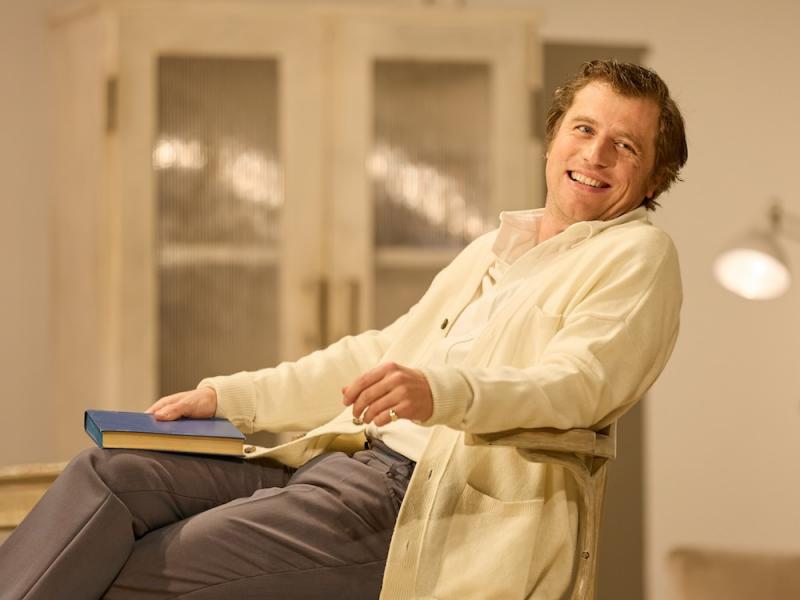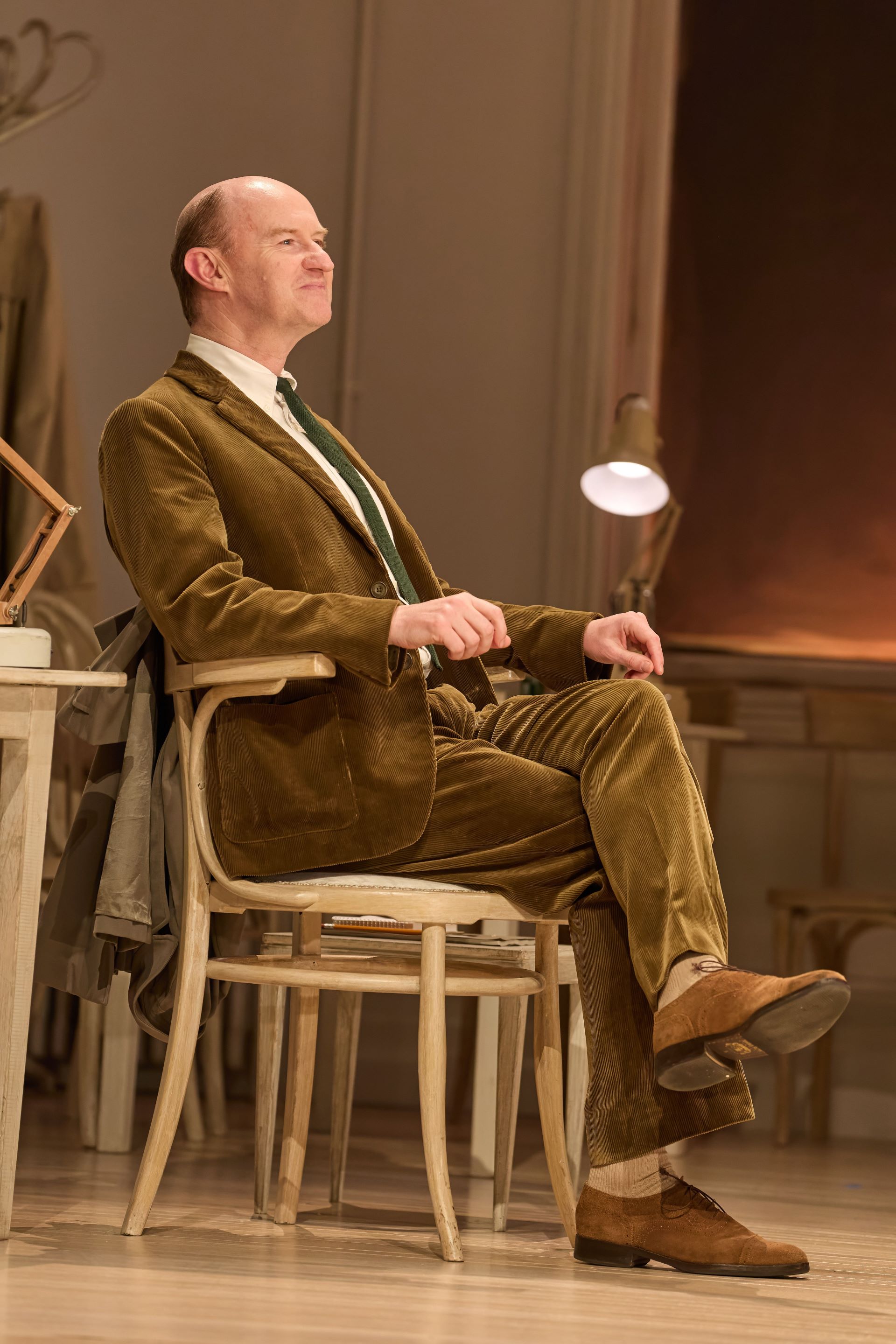The Motive and the Cue, Noel Coward Theatre - National Theatre transfer excels in the West End | reviews, news & interviews
The Motive and the Cue, Noel Coward Theatre - National Theatre transfer excels in the West End
The Motive and the Cue, Noel Coward Theatre - National Theatre transfer excels in the West End
Gielgud and Burton battle it out in Jack Thorne’s backstage drama

Plays about the theatre tend to go down well with audiences. Why wouldn’t they? The danger is that they become too cosy as actors and audience smugly agree on the transcendence of the artform. Jack Thorne’s The Motive and the Cue comes perilously close to falling into that trap, but, in the end, its wider preoccupations with old age, change, and the perils of the new, make it a rewarding and sometimes even challenging evening.
You have to admire Thorne’s versatility. Last week, Stranger Things – The First Shadow opened, for which he contributed to the original story. While that show attempts to push the limits of theatre, The Motive and the Cue has a deliberately old-fashioned structure and could have been written in the 1960s when it is set. As such, it fits much better into the gilded Noel Coward theatre than the modernist National where it first opened last spring.
In 1964, Richard Burton, then at the height of his fame and just married to Elizabeth Taylor, decided that he wanted to return to the stage, and invited Sir John Gielgud to direct him in Hamlet on Broadway. Gielgud’s career was at a low point when he reluctantly agreed to take on the job. Drawing on accounts by two of the actors involved, William Redfield and Richard L Sterne, Thorne explores what turned out to be a tempestuous and difficult time in the rehearsal room, even if the result was heralded as a success.
That is something the play addresses, whether great art can be produced out of chaos. Wearing a series of iconic roll neck jumpers, Johnny Flynn makes an explosive Burton, and brilliantly captures his aggressive unease and mellifluous Welsh tones, which stand out against the American accents of the cast. He comes to Gielgud determined to learn all the craft that the great actor can teach him, but at the same time convinced that he, Burton, is the future, and that his Hamlet will excite audiences with the spontaneity and danger that Gielgud’s lacked. Gielgud’s attempts to give him line readings are met with cold fury, and when Burton arrives drunk at rehearsal, he proceeds to humiliate his director.
 Mark Gatiss (pictured left) has the huge advantage of looking a little like Gielgud, especially in profile. But his performance as Gielgud is far more than just an impersonation. With his pained expressions, Gatiss conveys all the frustration of a man who feels left behind as the world moves on. He yearns to carry on playing the great classical roles and his mock humility is a way of coping with his sense of redundancy. There is the rivalry with Laurence Olivier that obsesses him, and the fact of his homosexuality, which is still against the law. The cast worship him and are desperate to learn from him, but Gielgud, famous for his gaffes, can’t quite hide his disappointment when they come up short, and, faced with Burton’s dysfunctional approach to the rhythms of Shakespeare’s language, he becomes acidly critical.
Mark Gatiss (pictured left) has the huge advantage of looking a little like Gielgud, especially in profile. But his performance as Gielgud is far more than just an impersonation. With his pained expressions, Gatiss conveys all the frustration of a man who feels left behind as the world moves on. He yearns to carry on playing the great classical roles and his mock humility is a way of coping with his sense of redundancy. There is the rivalry with Laurence Olivier that obsesses him, and the fact of his homosexuality, which is still against the law. The cast worship him and are desperate to learn from him, but Gielgud, famous for his gaffes, can’t quite hide his disappointment when they come up short, and, faced with Burton’s dysfunctional approach to the rhythms of Shakespeare’s language, he becomes acidly critical.
In between, trying to keep the peace, is Tuppence Middleton’s Elizabeth Taylor, holed up in a hotel suite, where she floats around in a peach negligee and attempts to keep herself entertained. One of the best scenes in the play is when she and Gielgud meet for breakfast and she gives him some clues as to how to deal with her damaged husband. When Gielgud laments the fact that he peaked at 25, she trumps with National Velvet at the age of 12. “You understand,” Gielgud says flutingly, “that I have no interest in your bosom?”.
The rest of the large cast, most of whom have transferred from the National, have little to do, although Sarah Woodward makes her mark as an acerbic Eileen Herlie. The extracts from Hamlet, as rehearsed by the cast, don’t always earn their place, except when, in an exceptionally moving moment, Gielgud recites Hamlet’s speech to the Players at the end of the first act, full of feeling for the craft he loves and that he feels is being traduced.
Es Devlin’s set creates the anonymity of a rehearsal room, with a back wall pierced by a series of tall windows. Rehearsals are private affairs, each one different according to the people who are gathered. Taylor longs to be let in, but if she were, the rehearsal would immediately become a performance. The actors are shocked by Burton’s drinking and by his attacks on Gielgud. As each new day passes, Gatiss girds himself to find a new way to deal with his difficult star.
Director Sam Mendes has himself sat in many rehearsal rooms and his production is full of affection for the idiosyncrasies of the actors and also illuminates Thorne’s compassion for all three central characters. We know that Gielgud’s career was, in fact, far from over and that he would eventually embrace the changes in theatre, that Burton had a huge talent that he wasted, and that Taylor was to show great courage throughout her eventful life. It is a play about more than just theatre, but there is no denying the final thrill when we learn that John Gielgud once played Hamlet in the very theatre in which we are sitting.
more Theatre
 Testmatch, Orange Tree Theatre review - Raj rage, old and new, flares in cricket dramedy
Winning performances cannot overcome a scattergun approach to a ragbag of issues
Testmatch, Orange Tree Theatre review - Raj rage, old and new, flares in cricket dramedy
Winning performances cannot overcome a scattergun approach to a ragbag of issues
 Banging Denmark, Finborough Theatre review - lively but confusing comedy of modern manners
Superb cast deliver Van Badham's anti-incel barbs and feminist wit with gusto
Banging Denmark, Finborough Theatre review - lively but confusing comedy of modern manners
Superb cast deliver Van Badham's anti-incel barbs and feminist wit with gusto
 London Tide, National Theatre review - haunting moody river blues
New play-with-songs version of Dickens’s 'Our Mutual Friend' is a panoramic Victori-noir
London Tide, National Theatre review - haunting moody river blues
New play-with-songs version of Dickens’s 'Our Mutual Friend' is a panoramic Victori-noir
 Machinal, The Old Vic review - note-perfect pity and terror
Sophie Treadwell's 1928 hard hitter gets full musical and choreographic treatment
Machinal, The Old Vic review - note-perfect pity and terror
Sophie Treadwell's 1928 hard hitter gets full musical and choreographic treatment
 An Actor Convalescing in Devon, Hampstead Theatre review - old school actor tells old school stories
Fact emerges skilfully repackaged as fiction in an affecting solo show by Richard Nelson
An Actor Convalescing in Devon, Hampstead Theatre review - old school actor tells old school stories
Fact emerges skilfully repackaged as fiction in an affecting solo show by Richard Nelson
 The Comeuppance, Almeida Theatre review - remembering high-school high jinks
Latest from American penman Branden Jacobs-Jenkins is less than the sum of its parts
The Comeuppance, Almeida Theatre review - remembering high-school high jinks
Latest from American penman Branden Jacobs-Jenkins is less than the sum of its parts
 Richard, My Richard, Theatre Royal Bury St Edmund's review - too much history, not enough drama
Philippa Gregory’s first play tries to exonerate Richard III, with mixed results
Richard, My Richard, Theatre Royal Bury St Edmund's review - too much history, not enough drama
Philippa Gregory’s first play tries to exonerate Richard III, with mixed results
 Player Kings, Noel Coward Theatre review - inventive showcase for a peerless theatrical knight
Ian McKellen's Falstaff thrives in Robert Icke's entertaining remix of the Henry IV plays
Player Kings, Noel Coward Theatre review - inventive showcase for a peerless theatrical knight
Ian McKellen's Falstaff thrives in Robert Icke's entertaining remix of the Henry IV plays
 Cassie and the Lights, Southwark Playhouse review - powerful, affecting, beautifully acted tale of three sisters in care
Heart-rending chronicle of difficult, damaged lives that refuses to provide glib answers
Cassie and the Lights, Southwark Playhouse review - powerful, affecting, beautifully acted tale of three sisters in care
Heart-rending chronicle of difficult, damaged lives that refuses to provide glib answers
 Gunter, Royal Court review - jolly tale of witchcraft and misogyny
A five-women team spell out a feminist message with humour and strong singing
Gunter, Royal Court review - jolly tale of witchcraft and misogyny
A five-women team spell out a feminist message with humour and strong singing
 First Person: actor Paul Jesson on survival, strength, and the healing potential of art
Olivier Award-winner explains how Richard Nelson came to write a solo play for him
First Person: actor Paul Jesson on survival, strength, and the healing potential of art
Olivier Award-winner explains how Richard Nelson came to write a solo play for him
 Underdog: the Other, Other Brontë, National Theatre review - enjoyably comic if caricatured sibling rivalry
Gemma Whelan discovers a mean streak under Charlotte's respectable bonnet
Underdog: the Other, Other Brontë, National Theatre review - enjoyably comic if caricatured sibling rivalry
Gemma Whelan discovers a mean streak under Charlotte's respectable bonnet

Add comment